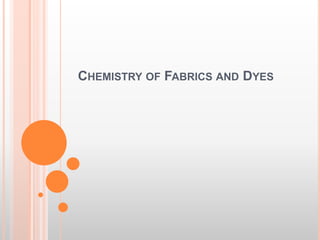
Chemistry of fabrics
- 1. CHEMISTRY OF FABRICS AND DYES
- 2. HISTORY OF FABRICS 5,000 B.C….Flax- a material that is used to make linens by spinning and weaving. 3,000 B.C….Cotton was used by the Egyptians. Cotton is made from a whiteish yellow vegetable fiber and will produce different qualities based on different plants. 3,000 B.C….Wool also dates back to around 3,000 B.C. and it was used by people in the Stone Age. Wool comes from the fleece of sheep and lamb and is a much thicker fabric.
- 3. NATURAL FABRICS VS. SYNTHETIC FABRICS Natural fabrics- made of fiber that either comes from an animal, a vegetable or a mineral. -Examples: Wool, Silk, Linen, Cotton, Flax, and Hemp. Synthetic fabrics (manufactured fabrics)- developed based on their use, such as in ropes. -Examples: Rayon, Spandex, Acetate, and Acrylic.
- 4. Wool Fabric N a t u r a l F a b r i c s Silk Fabric Flax Fabric Cotton Fabric Linen Fabric Hemp
- 5. Synthetic Fabrics Rayon Fabric Acetate Fabric Acrylic Fabric Spandex Fabric
- 6. SYNTHETIC MATERIALS Chemical process to form synthetic materials: 1. All synthetic textiles start in a molten liquid form. 2. That liquid is then forced through a spinneret. 3. Liquid synthetic fabric strings are then cooled and dried 4. They can then be woven into textiles.
- 11. HISTORY AND GENERAL INFORMATION OF DYES In aqueous solutions Dye vs. pigment….dyes = soluble and pigments = not soluble Technique of dying dates back to prehistoric times Natural vs. synthetic….natural dyes = first created in 1856 but quickly replaced with synthetic (man made) dyes Classified according to how they are used in the dyeing process
- 12. CLASSIFICATION OF DYES Organic/Inorganic Natural/Synthetic Area and method of application Chemical classification- Based on the nature of their respective chromophores. Nature of the Electronic Excitation(i.e, energy transfer colorants, absorption colorants and fluorescent colorants). According to the dyeing methods Anionic(for Protein fibre) Direct(Cellulose) Disperse(Polyamide fibres)
- 13. DIFFERENT TYPES OF DYES Group Application Direct Cotton, cellulosic and blended fibers Vat Dyes Cotton, cellulosic and blended fibers Sulfur Cotton, Cellulosic fibers Organic pigments Cotton, cellulosic, blended fabric, paper Reactive Cellulosic fiber and fabric Disperse Synthetic fiber Acid Wool, silk, paper, synthetic fibers, leather Basic Silk, wool, cotton
- 14. ACID DYES water-soluble anionic dyes applied to fibers such as silk, wool, nylon and modified acrylic fibers Attachment to the fiber is attributed, at least partly, to salt formation between anionic groups in the dyes and cationic groups in the fiber. Stick to fibers by hydrogen bonding, Van der Waals force, and ionic bonding Structure is made up of Azo dyes, Triphenylmethane, and Anthraquinone
- 15. BASIC DYES water-soluble cationic dyes applied to acrylic fibers, but find some use for wool and silk soluble in acid and insoluble in basic solution Bonded by ionic bonds
- 16. DIRECT (SUBSTANTIVE) DYES Bright and deep colors can be azo compounds, stilbenes, oxazines, or phtalocyanines Contain solubilising groups (mainly sulphonic acid groups) in an aqueous solution dye molecules being held in place mainly through Van der Waals forces and hydrogen bonds
- 17. MODIFIERS Common methyl and ethyl modifiers can be added Example: Original dye: red color Add four methyl groups to get violet color